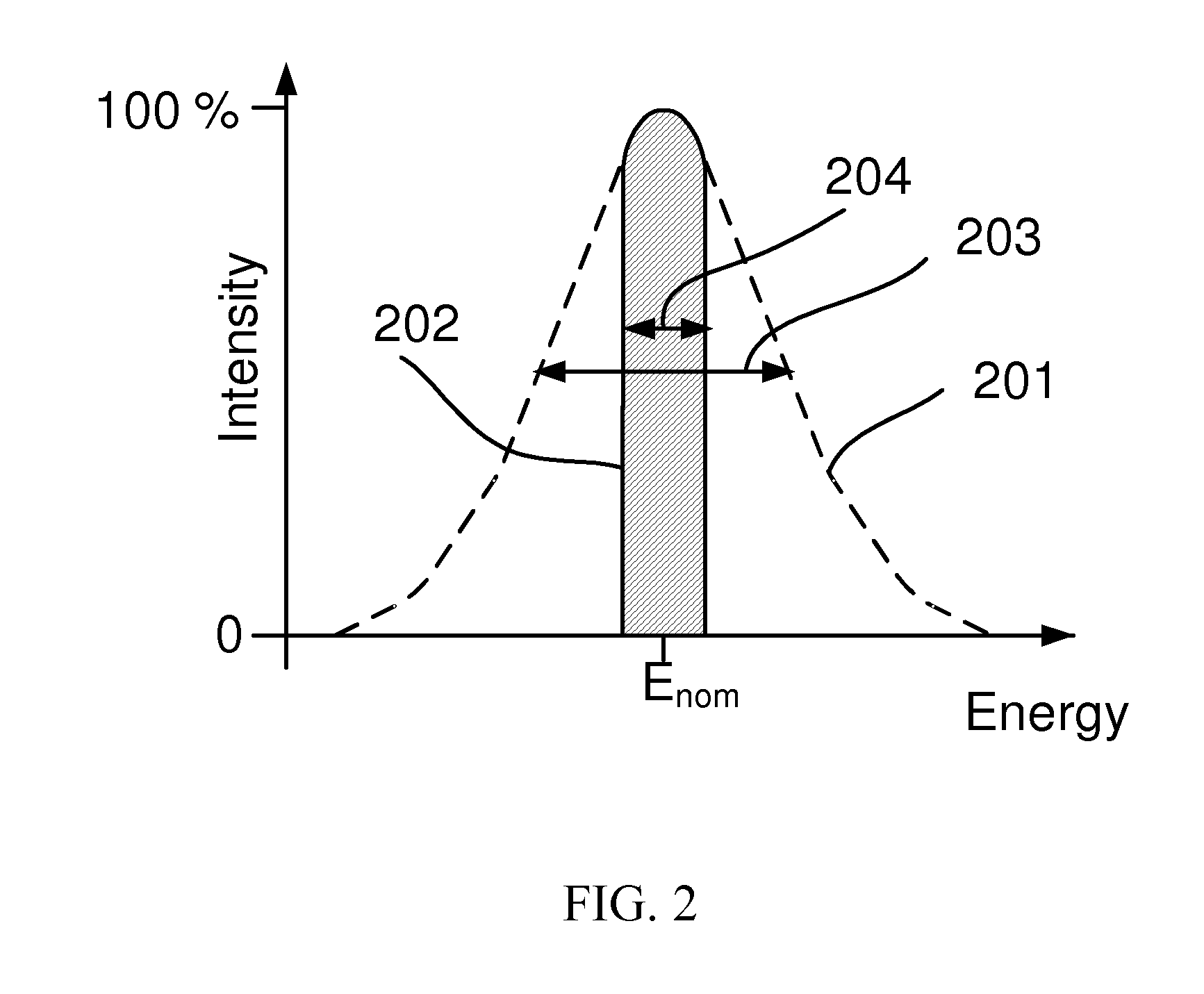Charged Particle Source with Integrated Electrostatic Energy Filter
a technology of electrostatic energy filter and charge particle source, which is applied in the direction of instruments, mass spectrometers, beam deviation/focusing by electric/magnetic means, etc., can solve the problems of complex machining and alignment of mechanical parts forming these hemispherical capacitors
- Summary
- Abstract
- Description
- Claims
- Application Information
AI Technical Summary
Problems solved by technology
Method used
Image
Examples
first embodiment
[0042]FIG. 1 shows the particle source according to the invention. FIG. 1 shows a particle source 100 comprising a charged particle emitter 102, in this embodiment a Schottky emitter. Due to an extraction field produced by extractor 112 the emitter emits a beam of charged particles 106 round axis 104. Extractor 112 also acts as a beam limiting aperture, transmitting only part of the current emitted by the emitter. As the beam is deflected in the x-direction, a projection of the beam is shown on the x-plane, projection 106a, and on the y-plane, projection 106b. The beam is focused on energy selective diaphragm 110 as a result of axial focusing fields generated between electrodes 112, 114 and 116. It is noted that these electrodes do not form a uni-potential lens, in other words: the energy with which the electrons leave electrode 116 is not the same as with which they enter electrode 112. The beam is deflected from the axis by a deflection field generated by electrode 116, and is dir...
second embodiment
[0060]Table 2 gives an overview of the excitations, here also referred to as the Fourier voltages) used on the different electrodes for the invention.
TABLE 2electrode excitations [Fourier voltage] for the second embodiment.Round lens excitationDipoleQuadrupolewith respect to emitterexcitationexcitationElectrode[Fourier voltage][Fourier voltage][Fourier voltage]1124600——1145584.7—1161000124 3.41181000——1201741−78656122103356418124727——
[0061]It is mentioned that, as the pre-slit optics are identical to the first embodiment, for a Schottky emitter the Coulomb interactions of this embodiment are also negligible when the current transmitted by the extractor (electrode 112) is less than approximately 30 nA.
[0062]FIG. 3 shows a 120° / 60° / 120° / 60° segmented electrode. The electrode shows 4 segments 301 . . . 304, with a central bore 305 arranged round axis 104. The first segment 301 is a 120° electrode, arranged at φ=0. Another 120° segment, segment 303, is arranged at φ=π. The two remainin...
third embodiment
[0065]FIGS. 4A and 4B schematically show the particle source according to the invention, in which FIG. 4A schematically shows the electrode lay-out and FIG. 4B schematically shows the rays.
[0066]FIG. 4A shows a particle source 100 comprising a charged particle emitter 102. Extractor 112 extracts electrons from the emitter. Electrode 402 deflects the beam of electrons from the axis, while electrode 404 deflects the beam back into the direction of the axis. Drift electrode 406 acts, together with electrode 404 and electrode 402, as a lens, while the “interior” of the electrode acts as a drift space. A focus is formed at the position of the energy selecting diaphragm 110. Electrode 408 bends the beam parallel to the axis, so that the beam exiting the source is parallel and aligned with the beam emitted by the emitter. After electrode 408 a further drift electrode 410 is placed, said further drift having identical voltages on all electrodes as drift electrode 406, and the two drift elec...
PUM
 Login to View More
Login to View More Abstract
Description
Claims
Application Information
 Login to View More
Login to View More - R&D Engineer
- R&D Manager
- IP Professional
- Industry Leading Data Capabilities
- Powerful AI technology
- Patent DNA Extraction
Browse by: Latest US Patents, China's latest patents, Technical Efficacy Thesaurus, Application Domain, Technology Topic, Popular Technical Reports.
© 2024 PatSnap. All rights reserved.Legal|Privacy policy|Modern Slavery Act Transparency Statement|Sitemap|About US| Contact US: help@patsnap.com










